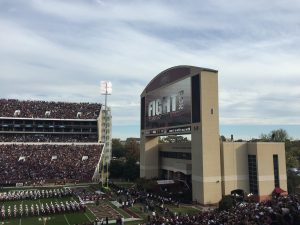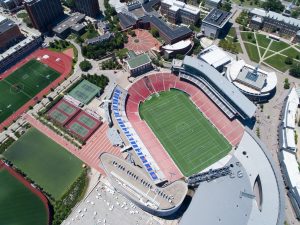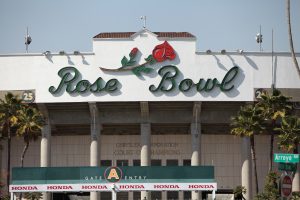
Baseball may be our nation’s pastime, but college football is one of the few sports that preserves its history as a living monument to the game.
Rather than rebuilding stadiums as Major League Baseball tends to do on a regular basis; 28 of MLB’s 30 stadiums were built after 1960; college football stadiums are regularly updated, rather than torn down and their historical significance scrapped.
For universities and their alumni, these stadiums are a source of pride. They are a place where everyone can revel in memories and pass down traditions from generation to generation.
In the Football Bowl Subdivision alone, there are dozens of college football stadiums built before 1930 still standing today. Many of them have undergone numerous updates that make them look far different from their original designs, yet nearly every one provides that same feeling of tradition and pride that college football fans can get behind.
Here’s a look back at the 10 oldest college football stadiums in the FBS.
Bobby Dodd Stadium at Historic Grant Field – Georgia Tech, 1913
The oldest college football stadium in the United States, Bobby Dodd Stadium, has faithfully served the Georgia Tech Yellow Jackets for more than a century.
Though the grounds on which the stadium was built had been used for football since 1905, it was not until 1913 that construction efforts on bleachers for Georgia Tech students began.
For the first ten years, the stadium seated less than 6,000 spectators, but it would undergo significant expansions over the century that followed. The capacity was eventually increased to 18,000, then 30,000, later 40,000, and most recently to 55,000 as part of a $75 million expansion in 2003.
From its opening in 1913 until 1988, the stadium was known as Grant Field in honor of one of the stadium’s first benefactors. The stadium was renamed in 1988 as a tribute to Bobby Dodd, a former head coach who holds the record for most wins in team history. The field, however, would still retain the name Grant Field.
The stadium was also the location of the most lopsided game in college football history. The game took place on October 7, 1916, when Georgia Tech defeated Cumberland College by an astounding 222-0.
One of the most important wins for the Yellow Jackets took place on November 29, 1917, when Georgia Tech claimed its first-ever conference title in a 68-7 win over Auburn, culminating in their first-ever national championship at the end of the season.
Eleven years later, on December 8, 1928, Georgia Tech hosted their archrival, the Georgia Bulldogs, in front of 40,000 fans. Georgia Tech won the game 20-6 to win their seventh conference title en route to an appearance in the Rose Bowl, where they would beat California to win their second national title.
The team would record three more undefeated seasons and two national titles while maintaining the home field advantage Bobby Dodd Stadium provided for them.
Recent NFL superstars who made their breakout performances at Bobby Dodd Stadium include Calvin Johnson, Demaryius Thomas, and Michael Johnson.
The stadium also hosts professional soccer matches occasionally throughout the year. The Major League Soccer expansion team Atlanta United FC chose Bobby Dodd Stadium for their inaugural 2017 season.
Davis Wade Stadium at Scott Field – Mississippi State, 1914
The Southeastern Conference is considered the premier conference in all of college football and its stadiums are among the largest in the world. Yet the comparatively small Davis Wade Stadium, home of the Mississippi State Bulldogs, boasts seniority over all of its SEC rivals.
Built in 1914 to replace the old Hardy Field, the stadium initially had a rather small capacity of just a few thousand seats before a series of expansions and seat additions took place in the 1920s and ’30s.
By 1948, the stadium had expanded to 35,000 seats; further expansions in 1986 and 2002 brought it to over 55,000.
The stadium was originally named New Athletic Field before the student body changed it to Scott Field in 1920 to honor celebrated Mississippi State sprinter Don Magruder Scott. It retained the name until 2000, when it was changed to honor longtime team supporter and contributor Floyd Davis Wade Sr.
The playing surface kept the name Scott Field, which led to the stadium’s official name being David Wade Stadium at Scott Field.
Since its 2014 expansion to 61,337 seats, there has seldom been any trouble filling the stadium; in fact, it reaches max capacity nearly every game.
Nippert Stadium – Cincinnati, 1915
The Cincinnati Bearcats have never been associated with a marquee conference like the Big Ten or ACC, so it’s surprising that they have been a consistent program for more than a century within the confines of Nippert Stadium.
The stadium was dedicated to James Gamble Nippert, a Cincinnati football player who died from a football injury in 1923, after a large donation from Nippert’s grandfather, Procter & Gamble executive James Gamble.
Upon its dedication in 1924, the stadium had a capacity of 12,000. This number would double after some adjustments and expansion in 1936, bringing the total capacity to 24,000.
Recent years have proven much more fruitful for fans, as the team has claimed conference titles in five of seven seasons between 2008 and 2014.
Though it’s used almost exclusively by the Bearcats, Nippert Stadium has served professional teams in the past. When the Cincinnati Bengals were founded in 1968, the team occupied Nippert Stadium for two years before moving into Riverfront Stadium in 1970.
The stadium also served as the home for Cincinnati’s professional soccer team, FC Cincinnati, in their inaugural 2016 USL season, shattering the league’s attendance records with constant sellouts.
Vaught-Hemingway Stadium at Hollingsworth Field – University of Mississippi, 1915
With no professional sports teams, the University of Mississippi Rebels are perhaps the most beloved team in the entire state of Mississippi. In turn, the university has rewarded more than a century’s worth of fans with a superb college football stadium where they can watch their favorite team.
Originally built as a federally sponsored project in 1915, Vaught-Hemmingway Stadium was a bit slow to expand to support a truly large attendance, capping at just over 40,000 by the 1980s.
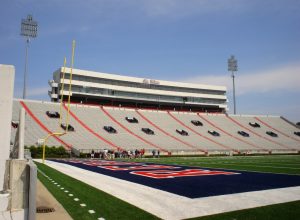
Major renovations and the addition of modern amenities between 1988 and 2002 have turned Vaught-Hemmingway Stadium into arguably the best sports venue in the entire state.
In 2008, an 84-foot-wide, state of the art video display, one of the largest in the country, was installed to replace the decade-old Jumbotron.
The stadium was originally named Hemingway Stadium after the university’s athletic chair Judge William Hemingway. In 1982, the name of former longtime head coach Johnny Vaught was added to the stadium name. Finally, in 1998 the field was named for Dr. Jerry Hollingsworth, thus giving the stadium the full name it has today.
Upon an expansion to 64,038 seats in 2016, the team quickly filled it to capacity at almost every game. The top six most-attended games in University of Mississippi history all took place during the 2016 season.
Camp Randall Stadium – Wisconsin, 1917
Built in 1917 atop a former Civil War training ground to help preserve the site, Camp Randall Stadium is home to the Wisconsin Badgers and is the oldest stadium for any of the Big Ten Conference teams.
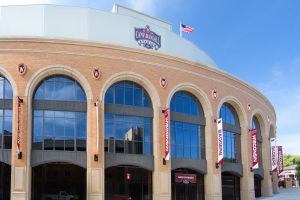
The 2004 expansion also helped the Badgers develop an incredible home-field advantage. The team has enjoyed home game winning streaks of 10 or more on four separate occasions, including an incredible 21-game win streak from October 31, 2009 through October 27, 2012.
Furthermore, football legends such as Alan Ameche, Ron Dayne, Melvin Gordon, and Russell Wilson have all played some of their finest games at Camp Randall Stadium.
Boone Pickens Stadium – Oklahoma State, 1920
As the oldest stadium in the Big 12 Conference, Boone Pickens Stadium has served the Oklahoma State Cowboys through thick and thin for more than a century.

Originally built to seat just 8,000 spectators, the stadium underwent its first expansion to 13,000 seats in 1930 before a much larger expansion to 30,000 seats in 1947. Several more expansions would follow in 1950 and 1971, leading to a max capacity of 50,000 between the 1970s and 1990s.
The most recent expansion in 2009 paved the way for the team to increase their attendance by nearly 50% for the average game.
Thanks to the success that the team saw in the years that followed, the fans didn’t mind attending the game in greater numbers either. The stadium reached a record attendance of 60,218 on November 23, 2013 in a 49-17 upset win over Baylor.
Among the star NFL players who made a name for themselves at Boone Pickens Stadium are NFL legend Barry Sanders, along with Dallas Cowboys star wideout Dez Bryant.
Husky Stadium – Washington, 1920

Built in 1920, the stadium has been remodeled several times to expand seating capacity, adding an average of nearly 10,000 seats every 15 years.
Thanks to its clever design, sound gets trapped inside the stadium, making it one of the loudest stadiums in the entire country.
During a famous game in 1992 against Nebraska, ESPN measured a decibel level of 133.6 decibels; the highest noise level ever recorded in a college football game and well above the threshold of pain.
With a capacity of over 70,000, Husky Stadium also holds the distinction of being the largest stadium in the Pacific Northwest, beating out the Seattle Seahawks’ CenturyLink Field by several thousand.
Speaking of the Seahawks, Husky Stadium actually served as the team’s temporary home in 2000 and 2001 before they made the move to CenturyLink Field in 2002.
David Booth Kansas Memorial Stadium – Kansas, 1921
Originally built by University of Kansas students, faculty, and fans in 1921, David Booth Kansas Memorial Stadium has been the home field for the Kansas Jayhawks for 95 years and is named to honor the Kansas students who died serving their country in World War I.
Several expansions between 1927 and 1965 increased Memorial Stadium’s capacity from its original 22,000 to the 50,000 it now seats. Additionally, a series of renovations between 1998 and 2014 have given the stadium a much more modern look.
The Jayhawks enjoyed two undefeated seasons at Memorial Stadium in 2005 and 2007, and earned their highest ever AP Poll ranking in ’07 after a 12-1 season and a Big 12 Conference title.
Memorial Stadium was also used by the Kansas track and field team from 1922 until its removal and replacement in 2014.
Neyland Stadium – Tennessee, 1921
Home of the Tennessee Volunteers football team, Neyland Stadium is the ninth oldest stadium in the FBS and the fifth largest in the country.
First built in 1921 to accommodate just 3,200 people, the Vols became one of the best college football teams in the country after moving into what was originally named Shields-Watkins Field.
In their first 30 years at the stadium, the Vols claimed seven conference titles and four national championships. All four national titles were won under the guidance of head coach General Robert Neyland. After Neyland passed away in 1962, the stadium was renamed in his honor.
There have been 16 different expansion projects in the years since the stadium opened, incrementally increasing the capacity by thousands every couple of years. After the most recent expansion in 1996, the Neyland Stadium capacity went up to 102,544, making it one of the largest stadiums in the United States.
Since attendance was first recorded at the games in 1946, the average attendance for each Vols game at Neyland Stadium has been 68,925 fans.
The turn of the century saw recording-breaking numbers, though, topping 107,000 at least 10 times since 2000 and setting a record with 109,061 in a game against the University of Florida on September 18, 2004.
Rose Bowl – UCLA, 1922
The home of the annual Rose Bowl Game, numerous college football and high school teams, as well as many professional sports teams, the Rose Bowl stadium stands as one of only two stadiums that ranks in the top 10 in both age and capacity.
Built in 1922 to replace Tournament Park in the wildly popular Rose Bowl game, the Rose Bowl was designed to host massive crowds and can officially hold 92,542 people, though it has topped 106,000 in the past.
The UCLA Bruins became permanent tenants of the Rose Bowl in 1982 and ended up winning back-to-back Rose Bowl games in their first few years at the stadium.
In addition to college football, the Rose Bowl has also hosted five Super Bowls, numerous soccer tournaments, the 1932 Summer Olympics, and many concerts.


